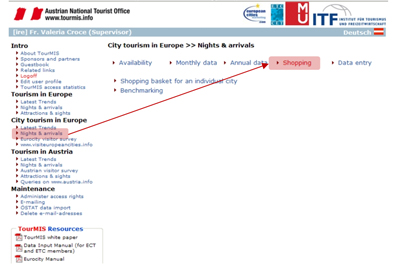City Break Shopping Barometer for ECM destinations

In times of crisis cut-price strategies are often seen as the only possible way to stimulate demand. Of course, such strategies only pay off if the price advantage is effective –how do you know if your destination is price competitive? And for which services, specifically? Now ECM and TourMis are able to offer a way to benchmark your city’s price competitiveness.
\n
\n
\n
\n
\n
\n
\n
\n
| \n
Sector
\n |
\n
Definitions
\n |
| \n
Accommodation
\n |
\n
Highest/lowest rate for 1 night in a standard single and double room on a week-day and weekend in a 4-star hotel.
\n |
| \n
Highest/lowest rate for 1 night in a standard single and double room on a week-day and weekend in a 2/3-star hotel.
\n |
|
| \n
Rate for 1 night, 1 bed in a dormitory, breakfast not included
\n |
|
| \n
Local transport
\n \n |
\n
Taxi from airport to city centre
\n |
| \n
Public transport from airport to city centre
\n \n |
|
| \n
Local public transport
\n |
|
| \n
Food and Beverage
\n |
\n
Price for a business lunch
\n |
| \n
Price for a 3-course evening meal
\n |
|
| \n
Price of a standard pizza/fast food meal
\n |
|
| \n
Soft drinks/beer
\n |
|
| \n
Espresso
\n |
|
| \n
Entertainment
\n |
\n
Opera
\n |
| \n
\n |
\n
Classical concert
\n |
| \n
\n |
\n
Biggest/main museum (permanent collection)
\n |
| \n
\n |
\n
Sightseeing bus
\n |
| \n
\n |
\n
Zoo (or similar attraction)
\n |
\n
\n
Table 1 – List of Shopping Items
\n
\n
Once the prices for all the items have been collected, data can be input into TourMIS (2), the online Marketing-Information-System commonly used by ECM members to share tourism statistics and benchmark a destination’s performance. With the aim of supporting ECM members with the task of data collection and analysis, a new section has been created by Prof. Karl Wöber, within the system. TourMIS provides a user-friendly interface to input prices in the database together with other useful information, such as the currency, the time of data collection and slight deviations from the standard definitions. If, for instance, there is no zoo in a destination, the researcher can provide the price for the entrance to a similar attraction, such as the Tropicario. Exceptions to the official definitions must be specified in the “note” string available next to the item, to make the slight difference in definition transparent. Notes will be displayed with the prices; all researchers should carefully avoid making any reference to the names of hotels or other service providers.
\n

Figure 1 – The link to the ECM City Break Shopping Barometer Data Entry in TourMIS.
\n
This section can be accessed from the www.tourmis.info web site after logging in (3). By clicking on the “Nights & arrivals” link in the “City tourism in Europe” menu and selecting the “Data Entry” link in the top right-hand corner, it is possible to access the link to the ECM City Break Shopping Barometer data entry section. This link gives users access to an initial screen where the name of the destination(for which the inputter has data input rights) is displayed.
\n
\n
The main aim of the project is to shed light on the costs differential existing across cities in Europe, collecting publicly available data for a specific set of items among those commonly consumed by visitors. Ranking destinations according to their costliness is not the final goal of the project: the focus here is to gain a deeper insight into the price differentials of services commonly used by tourists across city tourism destinations in Europe. Transparency is therefore a fundamental feature of this initiative: full compliance with the methodology and the provision of real prices is a basic requirement for the comparison of results.
\n
\n
\n
\n
\n
\n
\n
\n
| \n
\n
USAGE RIGHTS AND DATA PUBLICITY
\n The ECM City Break Shopping Barometer section in TourMIS can only be accessed by TourMIS users with data inputter rights for an ECM destination. If your destination doesn’t have an inputter for the TourMIS system, please contact Ms. Valeria Croce (e-mail to: valeria.croce@modul.ac.at).
\n At this stage, the data of the ECM City Break Shopping Barometer are intended for internal use only.
\n \n |
\n
\n
\n
\n
(1) High and low seasons may occur at different times of year in different destinations in Europe: for some cities the peak month may be August, while for others it may be June. In order to overcome this problem, cities should report the maximum and minimum rate for the year, corresponding to the peak and off-peak prices in the specific destination.
\n
\n
(2) The major aim of TourMIS is to provide information and decision support for tourism managers and scholars. TourMIS provides on-line tourism survey data, as well as various tools to transform data into precious management information.
\n
\n
\n
\n
\n
\n
\n